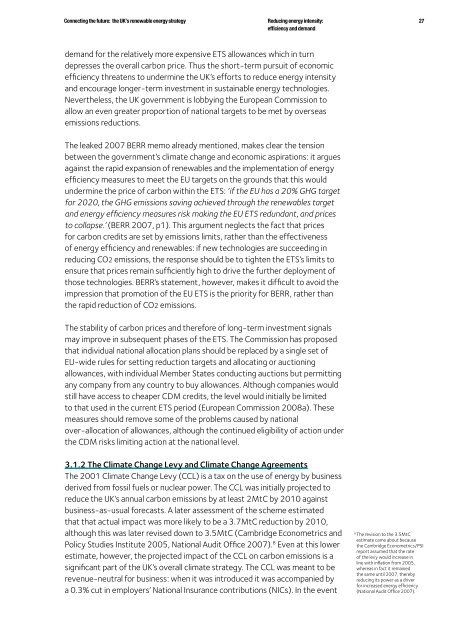Connecting the Future - Greenpeace UK
Connecting the Future - Greenpeace UK
Connecting the Future - Greenpeace UK
Create successful ePaper yourself
Turn your PDF publications into a flip-book with our unique Google optimized e-Paper software.
<strong>Connecting</strong> <strong>the</strong> future: <strong>the</strong> <strong>UK</strong>’s renewable energy strategy<br />
Reducing energy intensity:<br />
efficiency and demand<br />
27<br />
demand for <strong>the</strong> relatively more expensive ETS allowances which in turn<br />
depresses <strong>the</strong> overall carbon price. Thus <strong>the</strong> short-term pursuit of economic<br />
efficiency threatens to undermine <strong>the</strong> <strong>UK</strong>’s efforts to reduce energy intensity<br />
and encourage longer-term investment in sustainable energy technologies.<br />
Never<strong>the</strong>less, <strong>the</strong> <strong>UK</strong> government is lobbying <strong>the</strong> European Commission to<br />
allow an even greater proportion of national targets to be met by overseas<br />
emissions reductions.<br />
The leaked 2007 BERR memo already mentioned, makes clear <strong>the</strong> tension<br />
between <strong>the</strong> government’s climate change and economic aspirations: it argues<br />
against <strong>the</strong> rapid expansion of renewables and <strong>the</strong> implementation of energy<br />
efficiency measures to meet <strong>the</strong> EU targets on <strong>the</strong> grounds that this would<br />
undermine <strong>the</strong> price of carbon within <strong>the</strong> ETS: ‘if <strong>the</strong> EU has a 20% GHG target<br />
for 2020, <strong>the</strong> GHG emissions saving achieved through <strong>the</strong> renewables target<br />
and energy efficiency measures risk making <strong>the</strong> EU ETS redundant, and prices<br />
to collapse.’ (BERR 2007, p1). This argument neglects <strong>the</strong> fact that prices<br />
for carbon credits are set by emissions limits, ra<strong>the</strong>r than <strong>the</strong> effectiveness<br />
of energy efficiency and renewables: if new technologies are succeeding in<br />
reducing CO2 emissions, <strong>the</strong> response should be to tighten <strong>the</strong> ETS’s limits to<br />
ensure that prices remain sufficiently high to drive <strong>the</strong> fur<strong>the</strong>r deployment of<br />
those technologies. BERR’s statement, however, makes it difficult to avoid <strong>the</strong><br />
impression that promotion of <strong>the</strong> EU ETS is <strong>the</strong> priority for BERR, ra<strong>the</strong>r than<br />
<strong>the</strong> rapid reduction of CO2 emissions.<br />
The stability of carbon prices and <strong>the</strong>refore of long-term investment signals<br />
may improve in subsequent phases of <strong>the</strong> ETS. The Commission has proposed<br />
that individual national allocation plans should be replaced by a single set of<br />
EU-wide rules for setting reduction targets and allocating or auctioning<br />
allowances, with individual Member States conducting auctions but permitting<br />
any company from any country to buy allowances. Although companies would<br />
still have access to cheaper CDM credits, <strong>the</strong> level would initially be limited<br />
to that used in <strong>the</strong> current ETS period (European Commission 2008a). These<br />
measures should remove some of <strong>the</strong> problems caused by national<br />
over-allocation of allowances, although <strong>the</strong> continued eligibility of action under<br />
<strong>the</strong> CDM risks limiting action at <strong>the</strong> national level.<br />
3.1.2 The Climate Change Levy and Climate Change Agreements<br />
The 2001 Climate Change Levy (CCL) is a tax on <strong>the</strong> use of energy by business<br />
derived from fossil fuels or nuclear power. The CCL was initially projected to<br />
reduce <strong>the</strong> <strong>UK</strong>’s annual carbon emissions by at least 2MtC by 2010 against<br />
business-as-usual forecasts. A later assessment of <strong>the</strong> scheme estimated<br />
that that actual impact was more likely to be a 3.7MtC reduction by 2010,<br />
although this was later revised down to 3.5MtC (Cambridge Econometrics and<br />
Policy Studies Institute 2005, National Audit Office 2007). 8 Even at this lower<br />
estimate, however, <strong>the</strong> projected impact of <strong>the</strong> CCL on carbon emissions is a<br />
significant part of <strong>the</strong> <strong>UK</strong>’s overall climate strategy. The CCL was meant to be<br />
revenue-neutral for business: when it was introduced it was accompanied by<br />
a 0.3% cut in employers’ National Insurance contributions (NICs). In <strong>the</strong> event<br />
8 <br />
The revision to <strong>the</strong> 3.5MtC<br />
estimate came about because<br />
<strong>the</strong> Cambridge Econometrics/PSI<br />
report assumed that <strong>the</strong> rate<br />
of <strong>the</strong> levy would increase in<br />
line with inflation from 2005,<br />
whereas in fact it remained<br />
<strong>the</strong> same until 2007, <strong>the</strong>reby<br />
reducing its power as a driver<br />
for increased energy efficiency<br />
(National Audit Office 2007).




![[2007] EWHC 311 - Greenpeace UK](https://img.yumpu.com/22079793/1/184x260/2007-ewhc-311-greenpeace-uk.jpg?quality=85)











